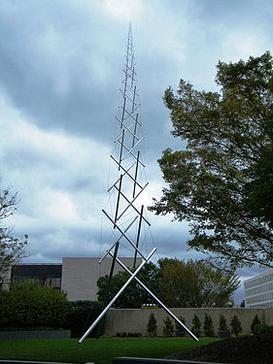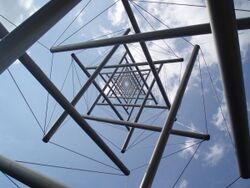Astronomy:Needle Tower
| Needle Tower | |
|---|---|
 | |
| Artist | Kenneth Snelson |
| Year | 1968 |
| Type | Aluminum & Stainless steel |
| Dimensions | 1,800 cm (60 ft × unknown ft × unknown ft) |
| Location | Hirshhorn Museum and Sculpture Garden, Washington, D.C., United States |
| [ ⚑ ] 38°53′16.4″N 77°1′20.99″W / 38.887889°N 77.0224972°W | |
| Owner | Smithsonian Institution |
Needle Tower is a public artwork by United States sculptor Kenneth Snelson located outside of the Hirshhorn Museum and Sculpture Garden in Washington, D.C., United States .[1]
Description
This 26.5 meter tall[2] abstract sculpture is a tapering tower made of aluminum and stainless steel.[1] The aluminum tubes act in compression, held in tension by the stainless steel cables threaded through in the ends of the tubes.[3]
Acquisition
The piece was a gift of Joseph Hirshhorn in 1974.[1]
Tensegrity
Snelson's unique sculpture style is well articulated in Needle Tower.
The structure style displayed is known as "tensegrity," a description given by Snelson's former professor Buckminster Fuller to the melding of tension and structural integrity. According to Snelson:
Tensegrity describes a closed structural system composed of a set of three or more elongate compression struts within a network of tension tendons, the combined parts mutually supportive in such a way that the struts do not touch one another, but press outwardly against nodal points in the tension network to form a firm, triangulated, prestressed, tension and compression unit.[4]
Symbolism
Much has been said about the geometric shapes seen in Snelson's works. Looking up from the inside of Needle Tower one may see the Star of David. According to Snelson, his works are not symbolic and it's common to see six-pointed stars in his work. In Needle Tower the six pointedness comes from the natural geometry of the three compression struts that make up each layer. Sets of three alternate with left and right helical modules, adding up to six when viewed upwards from the base of the tower.[4]
Conservation
In April 2010 conservation work was completed on the sculpture by the Hirshhorn Museum. It took 15 staff members to stand the tower upright after conservation completion.[5]
Needle Tower II
A second Needle Tower, Needle Tower II, was completed in 1968 and was acquired by the Kröller-Müller Museum in 1971. The piece resides in the museum's sculpture garden.[6]
Gallery
See also
- List of public art in Washington, D.C., Ward 2
References
- ↑ 1.0 1.1 1.2 Hirshhorn Museum; Sculpture Garden (2008). "Needle Tower, (sculpture).". Inventories of American Painting and Sculpture. Smithsonian. http://siris-artinventories.si.edu/ipac20/ipac.jsp?&profile=all&source=~!siartinventories&uri=full=3100001~!6413~!0#focus.
- ↑ "Needle tower". https://krollermuller.nl/en/page/3806.
- ↑ A Garden for Art, Valerie J. Fletcher, LOC # 97-61991, p.85
- ↑ 4.0 4.1 Kenneth Snelson. "FAQ". Kenneth Snelson. http://kennethsnelson.net/faq/.
- ↑ Hirshhorn Museum; Sculpture Gardens (2010). "Installation of Kenneth Snelson's "Needle Tower"". https://www.youtube.com/watch?v=xDNohDRWTvU.
- ↑ Acquisitions of Modern Art by Museums: Supplement. The Burlington Magazine Publications, Ltd., Feb. 1971, p 119.
External links
- Curious Skeletons by NASA
- Hirshhorn's collection entry
- Needle Tower on Kenneth Snelson's website
- Waymarking Entry for Needle Tower
 |




